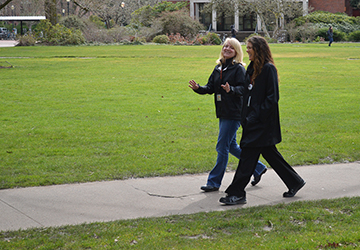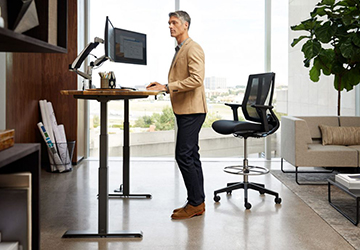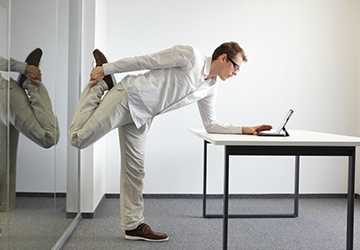How to Stay Active With Desk Job Exercises
In today's fast-paced, technology-driven world, many people sit at a desk for hours, leaving little time for physical activity. This sedentary lifestyle affects our health and can lead to unnecessary weight gain, muscle stiffness and increased risk of chronic disease.

Fortunately, there's a silver lining: You can counteract the harmful effects of desk work by integrating simple desk work practices seamlessly into your daily life. In the following sections of this article, we'll explore six valuable tips for staying active and in shape even with the demands of a desk-based work life.
The Power of Microfracture
Sitting for long periods can wreak havoc on your body, but breaking the cycle is easier than you think. One of the most effective ways to stay energized while working at your desk is to take regular breaks.
Set a timer to remind you every 30 minutes to get up, stretch, and move around your workspace. These short bursts of activity help improve circulation, relieve muscle tension and increase energy levels.
During these short breaks, you can perform simple stretches and exercises such as neck twists, shoulder rolls, or calf lifts. Although subtle, these movements can effectively prevent stiffness and improve overall health.
Deskercise: A Fun Approach
Deskercise is a fun term that refers to exercising discreetly at your desk. These exercises can be a real game-changer, keeping you active and engaged throughout your workday.
Desk Squats: Stand up from a chair and lower yourself without sitting. Repeat this move 10-15 times to engage your leg muscles.
Desk Push-Ups: Place your hands on the edge of your desk, shoulder-width apart, and push your body up and down, keeping your back straight. Aim for 10-15 reps to target your chest and triceps.
Desk Leg Raise: Sit on the edge of your chair with your feet slightly off the floor. Hold for a few seconds, then lower your legs. Repeat this move 10-15 times to build your core strength.
These tabletop exercises allow quick, practical training and are easily incorporated into your daily routine.
Walking and Talking
An easy way to incorporate more physical activity into your workday is to turn meetings into high-energy "walk and talk" sessions. Instead of talking on the phone at your office or desk, use the opportunity to speak on the go.

If you're working from home, consider holding virtual meetings while briskly pacing your living space. In an office, take a relaxing walk along the hallway or outside. Incorporating this practice into your daily life will encourage physical activity, enhance your creative thinking and problem-solving skills, and make your workday more energizing and engaging.
Active Commuting
Consider an active commute if you're lucky enough to live close to work. Walking or biking to work can give you plenty of exercise both at your desk and after you get off work. This approach is not only environmentally friendly but also allows you to enjoy fresh air and a change of scenery.
For those who live too far from work to walk or bike the entire distance, you can explore hybrid commuting options. Park farther away from work, take public transportation part of the way and walk the rest. Doing so can effortlessly include physical activity in your daily life.
Ergonomic Changes in the Workplace
Creating an ergonomic workspace is critical to maintaining health and productivity while working at a desk. Making the right ergonomic conditions is crucial to reducing stress and discomfort and improving your ability to stay active and focused. Here are some tips for an ergonomic setup:
Adjust Your Chair: Make sure your chair supports your lower back and promotes good posture. Your feet should be flat on the floor, and your thighs should be parallel to the floor.
Monitor Placement: Place your computer monitor at eye level and about an arm's length away. It ensures you don't have to strain your neck or eyes, providing greater comfort and focus.
Keyboard And Mouse: Keep your keyboard and mouse in a convenient place so your arms can rest comfortably at your sides. It prevents unnecessary stress on your wrists and shoulders.
Standing Desk: Consider a desk or desk converter that allows you to switch between sitting and standing positions. It provides variety to help you stay more active in your daily work life.

Designing an ergonomic workstation improves your comfort and creates a dynamic environment that encourages you to change positions regularly, mitigating the harmful effects of prolonged sitting.
Set Goals and Prioritize Activities
Setting goals and prioritizing physical activity is crucial to incorporating office exercise into your daily routine. First, set clear goals for your exercise routine. It might include a target number of steps, specific times to stand or stretch, or the number of desk exercises you want to complete.
Once you set your goals, prioritize them on your daily to-do list. Allocate specific time slots for training or exercise breaks and treat them as non-negotiable appointments. By making activity a part of your daily routine, you're more likely to achieve your intentions and maintain a healthy, active lifestyle.
Conclusion
Incorporating desk exercises into your daily routine can significantly impact your overall health. This exercise can boost your energy levels and significantly increase your productivity. If you diligently follow these six valuable tips, you can take control of your health and successfully live an active lifestyle, even sitting at your desk.
It's important to realize that the key isn't the amount of time you sit but maximizing the time available to move and stay active. So take these tips wholeheartedly and see how your desk job can be a stepping stone toward a healthier, more functional you.







